NVIDIA GeForce GTX 670 Review Feat. EVGA: Bringing GK104 Down To $400
by Ryan Smith on May 10, 2012 9:00 AM ESTOC: Power, Temperature, & Noise
Our final task is our look at GTX 670’s overclocking capabilities. Based on what we’ve seen thus far with GTX 670, it looks like NVIDIA is binning chips based on functional units rather than clockspeeds. As a result GTX 670 could have quite a bit of overclocking potential, albeit one still limited by the lack of voltage control.
| GeForce 600 Series Overclocking | |||||
| GTX 670 | EVGA GTX 670SC | GTX 680 | |||
| Shipping Core Clock | 915MHz | 967MHz | 1006MHz | ||
| Shipping Max Boost Clock | 1084MHz | 1188MHz | 1110MHz | ||
| Shipping Memory Clock | 6GHz | 6GHz | 6GHz | ||
| Shipping Max Boost Voltage | 1.175v | 1.162v | 1.175v | ||
| Overclock Core Clock | 1065MHz | 1042MHz | 1106MHz | ||
| Overclock Max Boost Clock | 1234MHz | 1263MHz | 1210MHz | ||
| Overclock Memory Clock | 6.9GHz | 6.6GHz | 6.5GHz | ||
| Overclock Max Boost Voltage | 1.175v | 1.162v | 1.175v | ||
Because of the wider gap between base clock and boost clock on the GTX 670 we see that it doesn’t overclock quite as far as GTX 680 from a base clock perspective, but from the perspective of the maximum boost clock we’ve slightly exceeded the GTX 680. Depending on where a game lands against NVIDIA’s power targets this can either mean that an overclocked GTX 670 is faster or slower than an overclocked GTX 680, but at the same time it means that overclocking potential is clearly there.
We’re also seeing another strong memory overclock out of a GK104 card here. GTX 680 only hit 6.5GHz while GTX 690 could hit 7GHz. GTX 670 is only a bit weaker at 6.9GHz, indicating that even with the relatively small PCB that NVIDIA can still exceed the high memory clocks they were shooting for. At the same time however this is a luck of the draw matter.
The EVGA card meanwhile fares both worse and better. Its gap between the base clock and and maximum boost clock is even larger than the reference GTX 670, leading to it having an even lower overclocked base clock but a higher overclocked maximum boost clock. The real limiting factor however is that it couldn’t reach a memory overclock quite as high as the reference GTX 670 – again, luck of the draw – which means it can’t match the overclocked reference GTX 670 as it’s going to be more memory bandwidth starved more often.
Moving on to our performance charts, we’re going to once again start with power, temperature, and noise, before moving on to gaming performance. We’ll be testing our GTX 670 cards at both stock clocks with the maximum power target of 122% (170W) to showcase what is possible at validated clockspeeds with a higher power cap, and a true overclock with a maximum power target along with the largest clock offsets we can achieve.
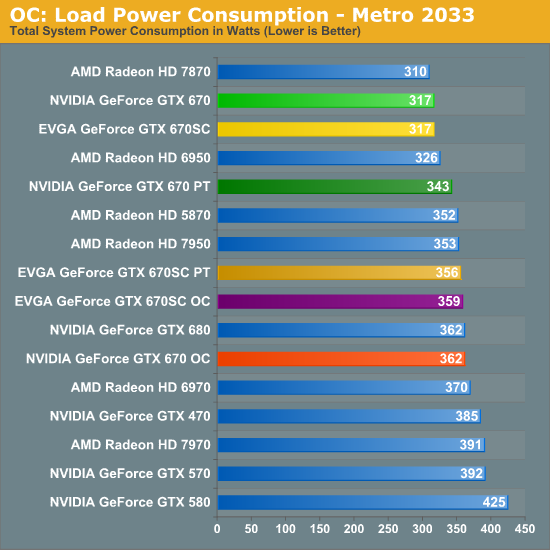
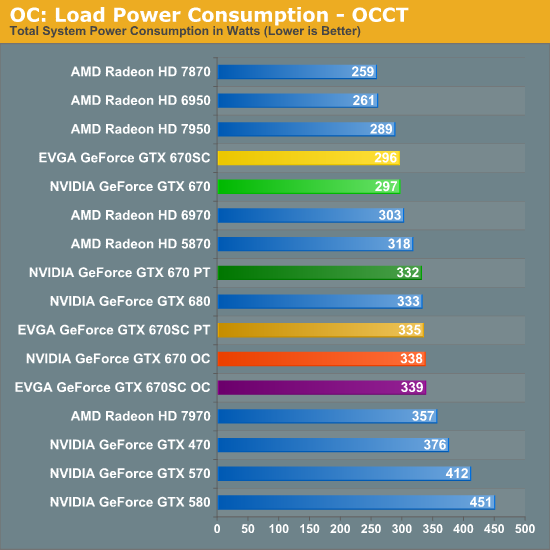
Not surprisingly, since we’re almost always operating within the realm of the power target as opposed to the TDP on the GTX 600 series, our power consumption closely follows our chosen power target. Cranking up the power target on the GTX 670 for example to 170W puts us within 6W of the GTX 680, which itself had a 170W power target in the first place. This is true for both Metro and OCCT, which means power consumption is very predictable when doing any kind of overclocking.
This also means that power consumption is still 18W-30W below the 7970, which in turn means that if these overclocks can close the performance gap, then the GTX 670 still has a power consumption advantage.
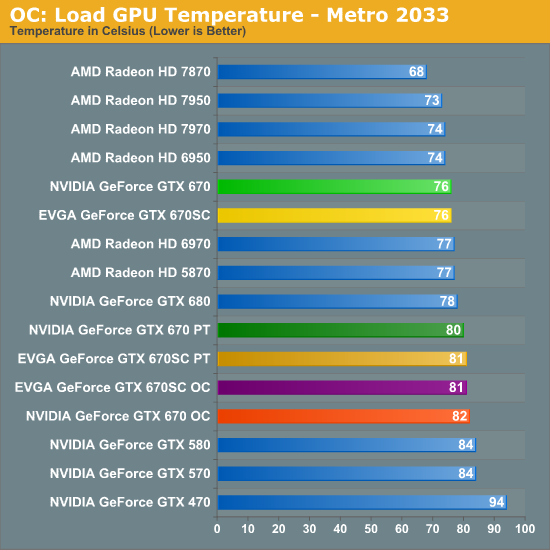
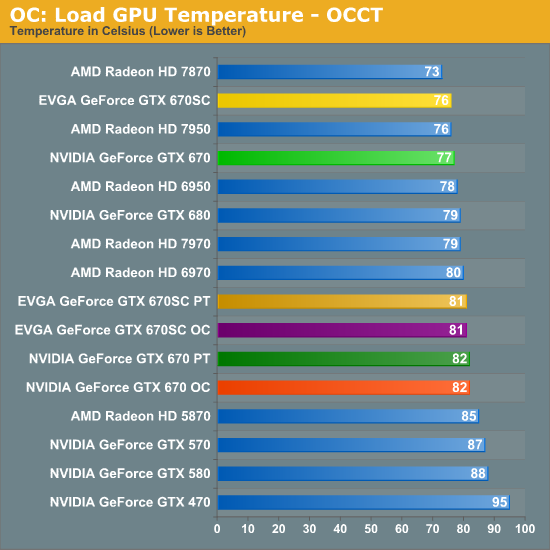
As to be expected, with an increase in power consumption comes an increase in load temperatures. However the fact that we’re only able to increase power consumption by about 30W means the temperature rise is limited to 4-5C, pushing temperatures into the low 80s. This does end up being warmer than the equivalent GTX 680 however due to the 680’s superior heatsink.
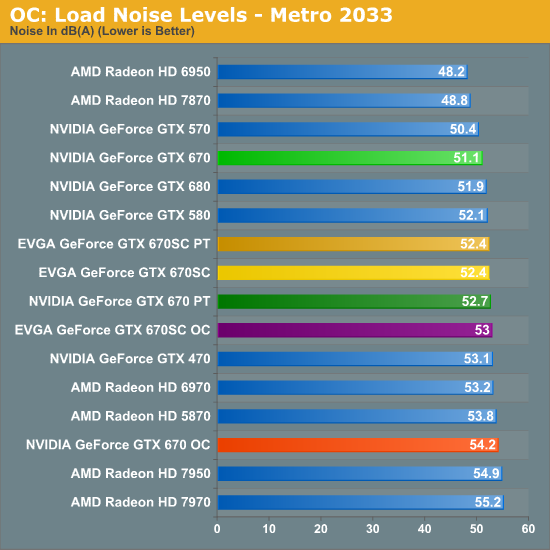

Finally, when it comes to noise we’re also seeing the expected increase, but again it’s rather small. Under Metro the amount of noise from the reference GTX 670 rises by under 3dB when pushing the power target higher on its own, while it rises 3dB when adding in our full overclock. Again the smaller cooler means that the GTX 670’s fan has to work harder here, which means our gaming performance may be able to reach the GTX 680, but our noise is going to slightly exceed it. As a point of reference, in the process we’ll also exceed the GTX 580’s noise levels under Metro. Still, in both OCCT and Metro none of our GTX 670 cards exceed the Radeon HD 7900 series, which means we've managed to increase our performance relative to those cards without breaching the level of noise they generate in the first place.










414 Comments
View All Comments
CeriseCogburn - Friday, May 11, 2012 - link
And let's add, since another amd fanboy has a big problem again - let's add, the great and "superior" amd Tahiti "gpu compute monster ! housefire !" gpu loses miserably in the compute benchmarks in this review, loses 3 tests to nVidia, to the gpu teh amd fanboys have spewed is very, very bad in compute compared to their loser amd 7970 core.Hey, how about that, now we both have some compute to talk about, and how amd is a loser failure, and nVidia won again, even in compute ! :)
Wow, I guess compute is really, really, really important like all the amd fanboys have been saying this entire thread.
CeriseCogburn - Friday, May 11, 2012 - link
Here's the idiot spew from you about compute on the prior page, amd fanboy: " Anyway, 7970 is a superior product over 680 if only for the compute performance it offers."LOL
It lost the benches here clueless.
ROFL
I love my amd fanboy friends.
versesuvius - Saturday, May 12, 2012 - link
Oh, you are back. Learned to read?Which benchmark are you talking about, know nothing imbecile? You are talking about this review? Are you trying to tell us that you cannot read or count? We already know that. Oh, you are trying to tell us that NVIDIA cannot get its act together even on the one benchmark that it has always done good, with 670 falling behind everyone? Hey, you are making progress. The NVIDIA way. Keep it up. You are doing fine.
CeriseCogburn - Sunday, May 13, 2012 - link
In this review nVidia won 3 compute benches and and won 2 compute benches.Nvidia 60%
amd 40%
Not like the very data here means anything to you.
Nfarce - Thursday, May 10, 2012 - link
One of my SLI 570s crapped out last month. Knowing the 670 was on the horizon but not willing to wait, I grabbed a 680 for $520 (EVGA Superclocked 2682 model - the only one that I could grab with F5 tapping). Looking at how close the 670 is to the 680, and (as of right now) looking at all the stock of 670s on Egg, I overspent by $100 when I could have had the Superclocked 670. I had no idea the performance was going to be that close.And who would have thought these things would actually be available? Kicking myself...kicking myself...
CeriseCogburn - Thursday, May 10, 2012 - link
At least you didn't spank out $579.99 plus tax and fees on the 7970 - which had a value drop off like rock from a cliff while official drivers were still absent.$130 plus tax and fees, crappy mismatched and total fail drivers, the usual strange and inexplicable crashing with ten fixes per incident any one of which may work "for a while" or with ones fingers crossed but you never know which one...
Yeah dude, I'm not feeling sorry for you.
Burticus - Thursday, May 10, 2012 - link
I like what I'm reading about the 670's performance and huge overclocking ability... but I'm sorry $400 is just too much for a video card for me. I am not the hardcore gamer I used to be, and sad to say I do a lot more on the console now than the PC. I mean when a card costs more than my car payment, that is just sad. For what? Bragging rights? 10 fps faster in Skyrim? Anything over 60 fps is pure gravy, people.Needs to get to $200 or less for this kid to get into the game. And I doubt 660 gets under that. I have a sneaky feeling they are going to make the 660 $299 and the 650 will be $199. Assuming a TI something doesn't pop up in the $250 range which probably will.
My "old" GTX 460 768mb can limp along for a few more months. Heh, that has been a good little card and it was only $150.
Nfarce - Thursday, May 10, 2012 - link
Well that's fine and dandy for you. But others have invested in 3 monitors and are running 5760x1080/1200 resolutions or one expensive one at a 2560x1440/1600. Older cards and especially sub-$400 cards just aren't going to run those kinds of resolutions with details up, which defeats the purpose of getting said monitors in the first place.PC gaming to play the latest and greatest maxed out never has been, nor will it ever be, cheap. I also am an avid console player (PS3). Dirt 3 and Crysis 2 on my PS3 and 55" LED looks like a PS2 game compared to it running DX11 on my PC with a 27" 2560x1440 LCD monitor and maxing out things with my 680.
SlyNine - Sunday, May 13, 2012 - link
I can get this 680GTX below 60FPS at 1080P. Op doesn't know what he's talking about.As far as console gaming. Its funny, you see screen shots and think that looks close. Than you actually play the games on both platforms and go, yea they look nothing alike.
dunce - Thursday, May 10, 2012 - link
I would like to see a 7970OC comparison? I was trying to find a 680 but gave up and got an 7970oc for $499 it's running at 1025Mhz and should be faster than a 680.